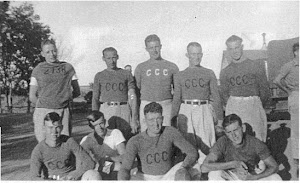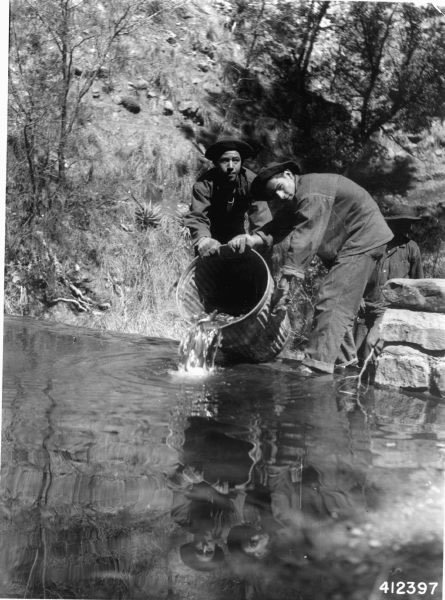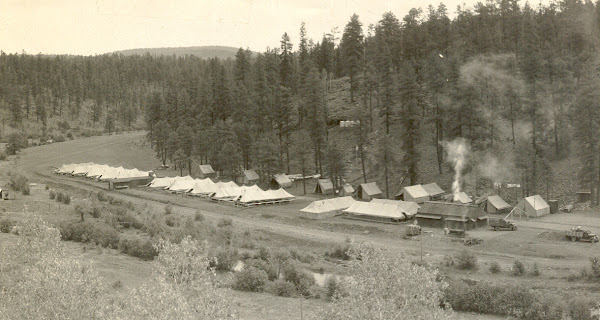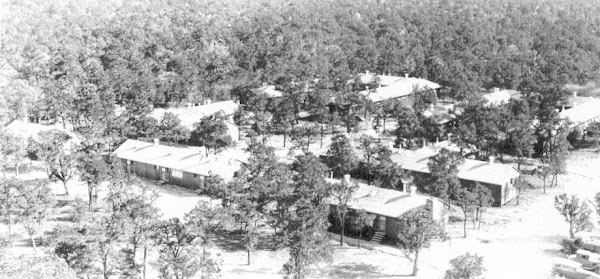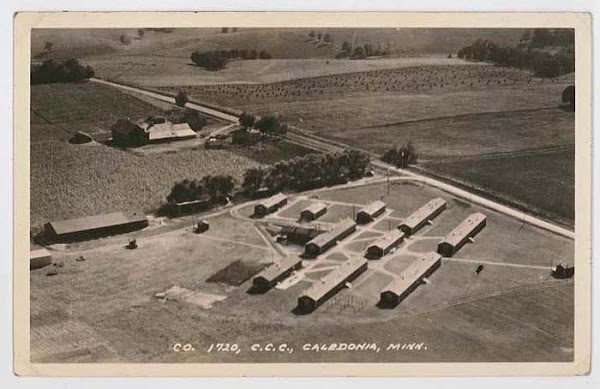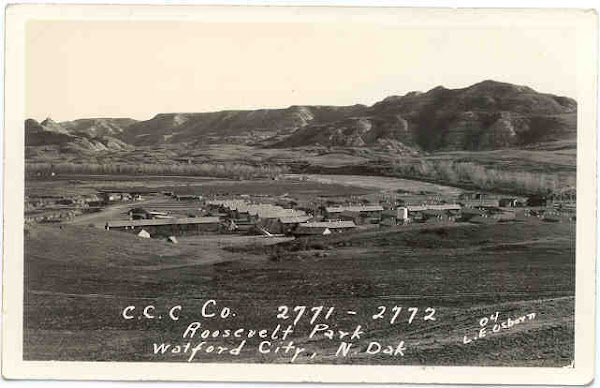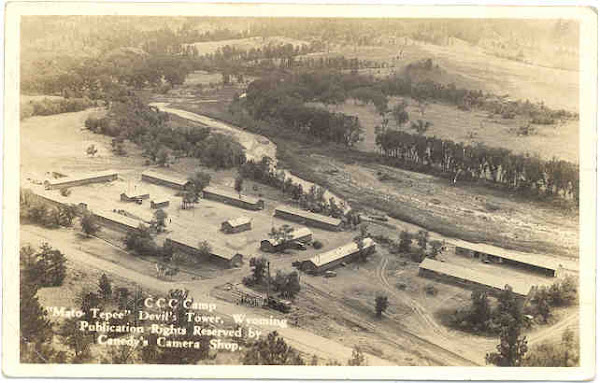Maryland is in the 1st Corps area, and in close proximity to
Washington, DC. A good deal of CCC work
was undertaken in this relatively small state, which may be due in part to the
fact that Maryland is so close to America’s seat of government. No doubt CCC projects in Maryland made for
appealing public relations visits for senators and congressmen and they
probably served as suitable examples of how the CCC funding was being put to
good use.
 |
| Beltsville, MD CCC camp, 1936, view looking toward camp HQ. |
The Federal Security
Agency Annual report of the Director of the Civilian Conservation Corps for
Fiscal Year Ended June 1942 includes a detailed accounting of the work done
by CCC enrollees at the Beltsville, Maryland Agricultural Research Center. The report is significant enough to warrant a
full quote here. The account begins on
page 55 of the report and reads as follows:
“Beltsville Agricultural Research Center
At the Beltsville Agricultural Research Center, Maryland,
are carried on agricultural-research projects and numerous field experiments of
the various bureaus and agencies of the Department of Agriculture.
This area includes specific areas assigned for experimental
purposes to the Bureaus of Animal Industry, Plant Industry, Dairy Industry,
Entomology and Plant Quarantine, Food and Drug Administration, Forest service,
and Soil Conservation Service, all of the Department of Agriculture; Biological
Survey of the Department of Interior since June 30, 1939, and the Bureau of
Standards of the Department of Commerce.
The Center has been the scene of an intensive CCC program since October
1933.
While work projects on the Center are similar in type to the
general CCC program, a rather heavy program for the development of the whole
area and particularly roads, fences, water and sewer lines, shed construction,
grading operations, and landscaping, was carried on by the CCC.
The first CCC camp at the Research Center came in October
26, 1933. In 1934 another was assigned
and in 1935 two more. One company went
out in October 1936, three continued until 1942, and the last one closing on
July 21, 1942. In October 1941, the
Plant Industry Camp (NA-1) at the national Arboretum, was transferred to
Beltsville supervision; it was closed however in December 1941.
From early 1941, one of the camps while still quartered at
Beltsville carried on national defense work at Fort Meade, Maryland. From February 1942 to its closing, another
Research Center camp devoted 60% of its work to Fort Meade projects.
 |
| Log cabin recreation center at the Beltsville, MD animal husbandry center. |
Accomplishments
For the fiscal year f1942, the major CCC contributions have
been the installation of pipe lines, construction and maintenance of roads and
parking areas, razing undesired structures, seeding and sodding, landscaping
and soil conservation work. This work is
of considerable value, when viewed as part of the nine-year camp program at
Beltsville. Since 1933, the camps have
constructed 39 bridges, 49 buildings of various types, over 65 miles of roads
and trails, 29,000 square yards of parking areas, and 12,000 feet of walks,
erected 130,000 rods of fence, installed 174,000 feet of water supply pipe
lines and 309,000 feet of other pipe and tile lines, planted 78,000 trees and
shrubs and seeded or sodded over 700 acres, done20,000 man-days of nursery
work, 3000 acres of general cleanup, moved many thousands of cubic yards of
earth incident to grading operations and performed many other operations of
great importance to the Center. Not only
have these accomplishments been of value to the Research Center, its many
participating units and the Department of Agriculture, but also much valuable
job training, experience and related education has been provided many young men
(mostly from rural areas) in these camps and this uplifting influence
undoubtedly has and will pay substantial dividends in the form of better men
and better workers so essential to the nation in this time of need.”
For a terrific history of the CCC in Maryland, click
Here.
For more photos of the CCC at Beltsville, Maryland, click
Here.
Maryland is also home to a CCC project that, over the years,
has come to be a place of national importance, even if most Americans have
never been there: Camp David in the
Catoctin Mountains. A National Park
Service brochure for Catoctin Mountain Park notes that in 1935 more than 10,000
acres of land in the Catoctin Mountains were acquired by the federal government
for development as the Catoctin Recreational Demonstration Area (RDA) with the
goal of finding new uses for marginal lands.
(Prior to the advent of the CCC, the Catoctin’s had been exploited –
overused, really – for the production of charcoal, which involved clear cutting
of forest, stripping of bark for tanning and general logging work.) A list of National Park CCC camps published
in The Civilian Conservation Corps and the National Park Service, 1933-1942
shows that the Catoctin RDA was home to Camp NP-3 (formerly SP-7) during
enrollment periods 14, 15 and 16 as well as camp SP-3 for an unspecified period
of time. Part of the purpose behind the
work in Catoctin was to develop recreational areas for the enjoyment of the
people from nearby urban areas, including Washington, DC. According to Ren and Helen Davis in Our Mark on this Land, the WPA laid out
the park and constructed the camp facilities while the CCC, beginning in 1939,
undertook reforestation work. One
interesting component of the CCC work at Catoctin Mountain Park noted in Our Mark on this Land is the work of CCC
enrollees to collect old fence posts from within the boundary of the park for
use in reconstructing fences in Gettysburg National Military Park (where the
CCC also worked).
While the bulk of Catoctin Mountain Park is accessible to
the public, Camp David is decidedly not open to the public and indeed there is
even a no-fly zone imposed in the airspace over Camp David. I know from personal experience that visitors
to Catoctin Mountain Park may drive within close proximity of Camp David
without even knowing it. The following
information about Camp David comes from the book, The President Is at Camp David, by W.Dale Nelson. What is now Camp David, was originally known
as Camp #3 or Camp Hi-Catoctin. With an
elevation of 1,800 feet, the location landed on a short list of sites deemed
suitable as a presidential retreat for President Roosevelt in 1942. At that time, the camp, which had been
intended as a recreational facility for families, included three units of six
four-cot cabins, a swimming pool, craft shop, and playing field along with an office,
showers and recreation hall. The Secret
Service would eventually occupy a former CCC barracks, which FDR christened
“221B Baker Street” after the fictional abode of Sherlock Holmes. The Secret Service agents called the
barracks, “The Long House.”
Paige’s book on the CCC and the National Park
Service lists all of the park service CCC camps in Maryland:
NP-1 Chesapeake & Ohio Canal, Montgomery
County
NP-2 Chesapeake & Ohio Canal, Montgomery
County
NP-3 Catoctin RDA, Frederick County
NP-4 Fort Washington, Prince Georges County
SP-1 Fort Frederick State Park, Washington County
SP-2 Patapsco State Park, Baltimore and Howard
County
SP-3 Catoctin RDA, Frederick County
SP-4 Gambrill State Park, Frederick County
SP-5 Elk Neck State Park & Forest, Cecil
County
SP-6 Maryland-Washington Metro/Rock Creek Park
Extension, Montgomery and Prince George County
SP-7 Catoctin RDA, Frederick County
The work of the CCC at the Chesapeake & Ohio Canal
National Historic Park is also worthy of note in any discussion of the CCC in
Maryland. Companies 325C and 333C,
composed of African-American enrollees from the urban centers of Philadelphia,
Baltimore and Washington, DC, worked to clear the historic canal alignment of
debris and remove vegetation from the tow path.
They’d managed to complete work on 22 miles of canal before the U.S.
entered World War and work was terminated.
For details of this project, including a photo, see Our Mark is on this Land.
Happy Days, the
CCC’s national newspaper, reported on the deaths of at least five individuals
affiliated with the CCC between 1933 and 1940:
Harry E. Jackson, an enrollee with Company 335, Brandywine,
Maryland drowned and the tragedy was reported on page 16 of the June 27, 1936
issue of Happy Days.
Enrollee Albert Barnes from the Beltsville, Maryland camp
was killed en route to a fire. Barnes
company number is not listed but his death was reported in the November 21,
1936 edition of Happy Days.
William Taylor, an enrollee in Company 2314 at Beltsville
drowned, as reported on page one of the Happy Days issue of July 9, 1938.
Another Beltsville enrollee, Abe H. Kelly, also of Company
2314, was killed in an automobile accident while on leave, according to the
October 7, 1939 issue of Happy Days.
Harold F. Kurtz was a U.S. Forest Service CCC inspector who
was killed in an auto accident according to the October 14, 1939. It is unclear whether Kurtz was somehow
affiliated with the Rockville, Maryland CCC camp or if, perhaps, the accident
occurred in Rockville.
We’ll close the Maryland entry for the State-By-State series
with some enrollment and work statistics from the Annual Reports for 1937 and
1939. The Annual Reports are a
terrific resource for things like overall enrollment by state and numbers of
individual tasks completed, however there isn’t any information pertaining to
specific work at individual locations in the various states. Nevertheless, it’s interesting to compare
work totals from year to year and to speculate as to why the numbers might have
fluctuated from one report to another.
The Annual Report of
the Director of Emergency Conservation Work for fiscal year ended June 30, 1937
lists totals for dozens of job types by state, including the following totals
for work in Maryland, for example:
Vehicle Bridges:
13
Buildings (all types, incl. cabins, latrines &
shelters): 43
Airplane Landing Fields: 3
Fighting Forest Fires: 6,727 man days
Fire Prevention:
3,883 man days
Enrollment figures from the 1936-1937 report give
the following monthly enrollment numbers for Maryland:
July 1936:
3,240
August 1936:
3,008
September 1936:
2,464
October 1936:
3,115
November 1936:
2,942
December 1936:
2,766
January 1937:
2,999
February 1937:
2,864
March 1937:
2144
April 1937:
2,476
May 1937:
2,262
June 1937:
1,910
The average breakdown of Maryland CCC camps by
type for the reporting period July 1936-June 1937 was as follows:
State Forest:
13
Mosquito Control:
2
Animal Industry:
3
Agricultural Engineering: 3
Soil Conservation:
3
State Parks:
2
Military Reservations: 3
Naval Reservations: 1
The Annual
Report of the Director of the Civilian Conservation Corps for fiscal year ended
June 30, 1939 (note the change in the title from “Emergency Conservation
Work” to “Civilian Conservation Corps.”) gives these totals for the same types
of jobs:
Vehicle Bridges:
8
Buildings (all types, incl. cabins, latrines &
shelters): 28
Airplane Landing Fields: 0
Fighting Forest Fires: 3,346 man days
Fire Prevention:
40 man days
Enrollment figures from the report give the
following monthly enrollment numbers for Maryland:
July 1938:
2,932
August 1938:
2,737
September 1938:
2,427
October 1938:
3,024
November 1938:
2,920
December 1938:
2,680
January 1939:
3,031
February 1939:
2,928
March 1939:
2,089
April 1939:
2,947
May 1939: 2,817
June 1939: 2,385
The breakdown of Maryland CCC camps by type for
the reporting period July 1938-June 1939 was as follows:
National Parks/Monuments: 2
State Parks:
2
State Forest:
7
Animal Industry: 3
Agricultural Engineering: 3
Soil Conservation Service: 3
Sources
Davis, Ren & Helen, (2011), Our Mark on This Land: A Guide to the Legacy of the Civilian
Conservation Corps in America’s Parks, The McDonald & Woodward
Publishing Company.
Federal security Agency Annual Report of the Director of the
Civilian Conservation Corps, Fiscal Year Ended June 1942 (no publisher noted).
Nelson, W. Dale, (1995).
The President is at Camp David,
Syracuse University Press.
Paige, John C. (1985), The Civilian Conservation Corps and
the National Park Service, 1933-1942.
National Park Service, U.S. Dept. of the Interior.
U.S. Government Printing Office, Annual Report of the Director of Emergency Conservation Work, Fiscal
Year Ended June 30, 1937.
U.S. Government Printing Office, Annual Report of the Director of the Civilian Conservation Corps Fiscal
Year Ended June 30, 1939.
The photos of the Beltsville, Maryland CCC work are United States Forest Service images from Stan Cohen's book The Tree Army: A Pictorial History of the Civilian Conservation Corps, 1933-1942.
Copyright, 2014, Michael I. Smith



























